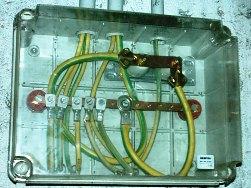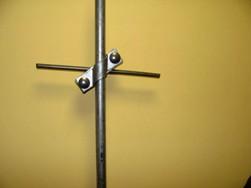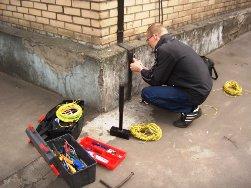Categories: Featured Articles » Electrician at home
Number of views: 65130
Comments on the article: 2
How to make grounding
 Modern technology and practice of manufacturing grounding systems
Modern technology and practice of manufacturing grounding systems
Grounding device - An important element of the system of protecting people from electric shock. Therefore, it is necessary to pay due attention to the issue of manufacturing grounding at the project stage.
A grounding device can be manufactured in many ways, the criterion for choosing a specific one is to provide the desired resistance (8 Ohms for 220V, 4 Ohms for 380V) and stability of parameters throughout the entire operation period.
Destabilizing factors
The instability of the grounding properties is caused by a change in the resistance of the soil, when the external temperature (winter / summer) changes and the corrosion of the grounding elements. They are struggling with seasonal changes by laying grounding elements below the groundwater level and below the freezing temperature of the soil. The freezing depth is different for each locality, in the middle zone of Russia, about 1.5 m.
Ways to extend service life
It is necessary to deal with corrosion in very expensive ways - using grounding elements made of stainless steel and metals with a corrosion-resistant coating. There is an easier way - to increase the number of parallel grounding elements or their thickness. The second method is much less effective, because around the rods or pipes, a “coat” of rust is formed, which increases the grounding resistance.
The traditional method of manufacturing a ground loop
The most common way to solve these problems is to drive metal rods about 2-3 m long into the soil from trenches 0.7-0.8 m deep.
The upper ends of the rods are connected into a contour of a square or triangular shape, with a size of not more than 16 x 16 m. Usually 3 x 3 x 3 or 4 x 4 x 4 x 4 m. The union of the rods is done by welding with a metal strip of 5 x 30 mm. The places of welding are painted over, the trench is buried, and the strip is led to the entrance shield and, if necessary, is carried out through the building. Bolts are welded to connect the internal ground loops to the strip.
It is very convenient and cost-effective to make a ground loop at the construction stage. In this case, it is placed along the foundation. It is necessary to make the circuit closed and covering a large area. To reduce costs, you can use galvanized materials (pipe cuts, metal structures, fittings). The conductor cross section for the grounding device must not be less than 75 square millimeters.
Modern method of manufacturing a ground loop
 Recently, a modular pin grounding system has gained great popularity. It has several advantages over traditional.
Recently, a modular pin grounding system has gained great popularity. It has several advantages over traditional.
The first advantage is the low complexity of manufacturing. Good grounding one person does in 2-3 hours.
The second is a lower price. The manufacture of a classical system without materials costs from 8000 p., Modern from 3000 p.
The third advantage is a guaranteed service life of 40 years (some companies give up to 100 years).
Technology and materials for the modular pin earthing system
The modular pin earthing system is based on replacing the circuit of many short pins with one, but long. Usually up to 20 m. To protect against corrosion, a steel pin with a diameter of 17-25 mm with a copper coating 250 microns thick is used. Such a ground electrode system is not afraid of seasonal temperature fluctuations, because at a depth of three meters it is already stable +4, and at 20m up to +10.
A long grounding pin is assembled from segments 1.2-1.5 m long with an external thread on both sides. Segments are connected using threaded brass couplings. A pointed tip made of hardened steel is put on the first segment. The pins are driven into the ground using a 1.5 kW electric hammer drill.
 The technology is this: In the soil, a recess is made with a depth of 30 cm × 30 cm on the shovel’s bayonet. A tip is screwed onto the first ground electrode segment and a brass sleeve is screwed onto the ground segment, into which the head is screwed. The head is a bolt, with a recess in the upper part to center the working element of the punch.
The technology is this: In the soil, a recess is made with a depth of 30 cm × 30 cm on the shovel’s bayonet. A tip is screwed onto the first ground electrode segment and a brass sleeve is screwed onto the ground segment, into which the head is screwed. The head is a bolt, with a recess in the upper part to center the working element of the punch.
After the first segment is clogged into the ground by 1 m of length, the head is unscrewed, anti-corrosion paste is added to the coupling and the next segment is twisted. On the next segment, its own coupling is screwed, the head is inserted into it and the process is repeated.
The last segment is clogged to such a depth that the bottom edge of the coupling touches the ground. Then the coupling is unscrewed and a special brass clamp is put on the end of the pin for connection to the ground loop.
The connection is carried out, for example, using a galvanized steel cable with a diameter of 10 mm. The junction is insulated with a special rubberized insulating tape. Next, the connection point is marked with a peg with a sign and filled with soil. Experience has shown that for the middle zone of Russia, 6-7 segments are sufficient.
Approximate prices for components
The copper-coated core is 17mm in diameter and 1.2m long is 460 rubles. Coupling 255 rub. Tip 100 rub., Head 170 rub., Clamp 360 rub., Anti-corrosion paste 360 rub., Insulating tape 6 meters 500 rub., hammer drill 300 rub., Galvanized wire rope 8-10 mm 30 rub / meter.
conclusions
Given the prevailing prices for construction work and finished housing in Russia, the cost of the grounding system is just ridiculous, if it weren’t for sadness from the level of salaries of 80% of the population.
The classic way to make a grounding device: Grounding device for a country house
See also at e.imadeself.com
:
